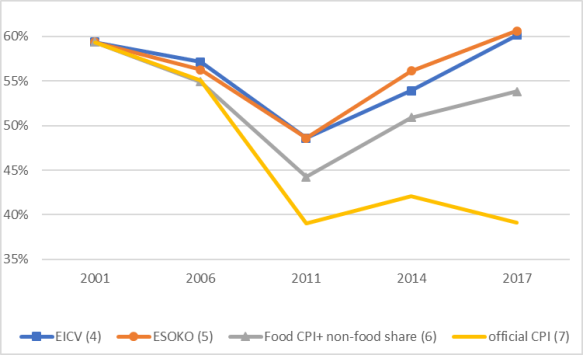This blogpost aims to explore the question of inflation in Rwanda, which has emerged as the last remaining issue required to resolve the disagreement about Rwanda’s poverty statistics. Using Consumer Price Index (CPI) price data, the National Institute of Statistics of Rwanda (NISR) (2016) and the World Bank (2018) claim that poverty decreased by 6 percentage points from 45% between 2010/11 and 2013/14, and then by a further 1 percentage point between 2013/14 and 2017/18 (NISR 2018).
Fig: extreme poverty rates accounting for inflation
However, blogs posted on roape.net (see the series, Poverty and Development in Rwanda on the website) have shown that the price data contained in the Integrated Household Living Conditions Survey or Enquête Intégrale sur les Conditions de Vie des ménages (EICV) survey itself, as well as in the separate ESOKO dataset, indicate a much higher inflation rate over this period, resulting in a sharp increase in poverty over the same period.
… This finding provides the first direct evidence of statistical manipulation as it means that NISR reported results that corresponded to a 4.2-4.7% inflation rate between 2011 and 2014, instead of the 13.8% inflation that it claims to have used.
You can read the whole post here.
The World Bank, which has repeatedly endorsed the figures coming out of Kigali, responded with this:
The key issue of Rwanda poverty measurement between 2010/11 and 2013/14 is that the consumer price index (CPI) and the NISR price index, called the Cost of Living Indicator (COLI), do not seem to be consistent. The national CPI shows that the inflation rate between 2010/11 and 2013/14 is 23%. NISR’s COLI uses the same CPI data, and the results show Kigali’s inflation rate is very similar to the national CPI trend, but other regions show very different trends. Further, the national average of COLIs show only around 5 percent for the same period, although there is no clear theory to guarantee that the national average of COLIs and the national CPI need to be consistent.
Is NISR’s approach flawed?
A working paper by Fatima and Yoshida (2018) found NISR’s 2016 approach – the latest official methodology – to be technically sound, but the inconsistency between CPI and COLI needs further research. The working paper, “Revisiting the Poverty Trend in Rwanda: 2010/11 to 2013/14,” is publicly available. NISR and World Bank teams are initiating a new joint research program, which will start in May 2019.
Is there any evidence that NISR manipulated poverty estimates?
No. NISR made all survey data and questionnaire as well as full documentation of their poverty measurement methodology freely available to anyone on their website. NISR has been fully open to any questions and requests from the World Bank team. Indeed, NISR welcomed technical views on their methodology and expressed strong interest in benefiting from global best practices. We have not found any clear sign of errors or manipulations.
The dispute appears to be over price indices. While I would not put it past an autocratic regime like Kagame’s to fake data, I also think that the Bank is taking on a lot of reputation risk for standing with NISR. I look forward to the outcome of the Bank’s joint research program with NISR.
A potential silver lining in all of this is that NISR will emerge as a more independent outfit (relative to politicians) that is guided by methodologically-sound approaches to making the country legible to its citizens and rulers.
